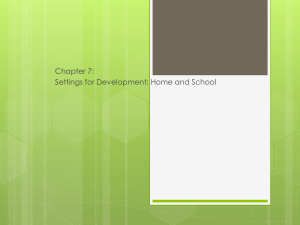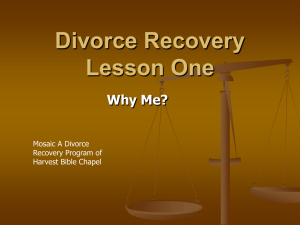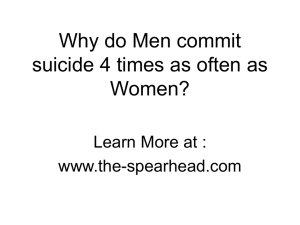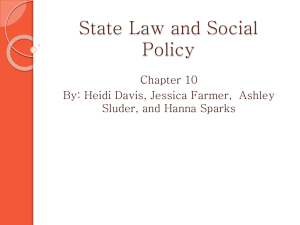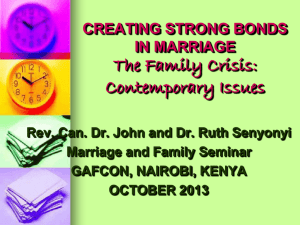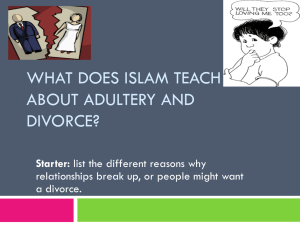Helping Children Through Divorce
advertisement
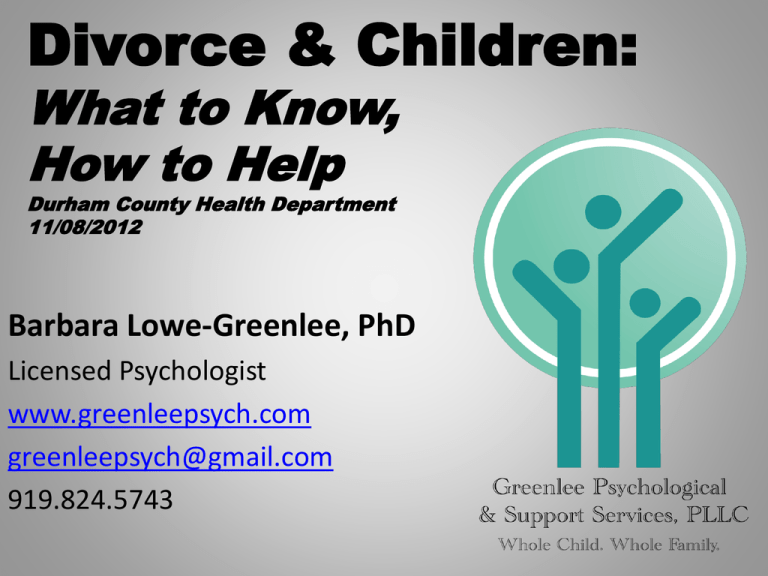
Divorce & Children: What to Know, How to Help Durham County Health Department 11/08/2012 Barbara Lowe-Greenlee, PhD Licensed Psychologist www.greenleepsych.com greenleepsych@gmail.com 919.824.5743 Objectives 1. Name 3 common ways that divorce can impact children and/or adolescents 2. List 3 characteristics of a co-parenting relationship that are pro-child 3. Identify 3 primary characteristics of a High Conflict Custody Divorce (HCD) 4. List 3 characteristics of Parent Alienation Syndrome 5. Name 3 interventions for families going through separation or divorce that are pro-child Road Map A. Divorce and Family Impact 1. 2. 3. 4. 5. 6. 7. Paradigm Clarify Terms Statistics Stages of Divorce Individuals Differences and Risk Factors Infants, Toddlers, Preschoolers, Children, Adolescents Children with Special Needs B. Post Divorce/Separation Parenting 8. 9. 10. 11. 12. High Conflict Divorce PAS Children Who Resist Contact Parallel Parenting Co-Parenting C. Special Consideration: Domestic Violence and Abuse D. Prevention, Intervention, and Resources E. Selected Sources Divorce and Family Impact Paradigm (Bronfenbrenner, 1979) Use of Terms Broad Definitions Family Marriage/Couple Children Statistics: Divorce – The current rate of divorce is estimated at approximately 50% (Various) – Higher rate for families with children with special needs (Marshak & Prezant, 2007; Various) Statistics: Our Changing Family Structure – 2008, 6.8 million couples living together, increase of 800% since 1960s (Browning & Artet, 2012). • Percentage of couples doubled from 1980 to 1998 – In 2011, 69 percent of children ages 0–17 lived with two parents (65 percent with 2 married parents), 27 percent with one parent, and 4 percent with no parents (America’s Children in Brief: Key National Indicators of Well-Being, 2012). – Among children living with neither parent, more than half lived with a grandparent (America’s Children in Brief: Key National Indicators of Well-Being, 2012). – Seven percent of all children ages 0–17 lived with a parent who was in a cohabiting union. A cohabiting union could involve one parent and their cohabiting partner or two cohabiting parents (America’s Children in Brief: Key National Indicators of Well-Being, 2012). Statistics: Our Changing Family Structure – The percentage of all births that were to unmarried women more than doubled between 1980 and 2009, with the largest increases for women in their twenties (America’s Children in Brief: Key National Indicators of Well-Being, 2012). – In 2010, 40.8 percent of births were to unmarried women (America’s Children in Brief: Key National Indicators of Well-Being, 2012). – Stepfamilies are the fastest growing type of family in the U.S. (Browning & Artet, 2012). Statistics: Our Changing Family Structure Trends Child Research Brief, www.childtrends.org Families at Greater Risk for Divorce – Previous Divorce – “Cohabitation Effect” – Unmarried Parents – Children with Special Needs – Lower Income – Lower Education (Browning & Artet, 2012; Hetherington & Stanley Hagan, 1999). Why is Divorce Stressful for Children 1. Loss of family structure, routines, and “the family I’ve always had” 2. Loss of/changes in primary attachments 3. Fear of abandonment 4. Absorbing hostility between parents Short Term Impact Many children experience challenges for months after the divorce (Hetherington & Stanley Hagan, 1999). – – – – Increased Depression Increased Anger; Aggression Increased Anxiety Increased Demanding, Noncompliant, and/or Antisocial Behaviors – Decreased Cognitive Agency and School Performance – Decreased Self-Regulation – Conflict in Relationships Over Time…. • These problems diminish over time as the family reorganizes and stabilizes; nonetheless the research shows that children from divorced families demonstrate less social, emotional, and academic adjustment then there peers from non-divorced parents. • Sometimes problems appear later. • Children who, move from conflictual abusive, and/or neglectful homes into stability because of divorce can demonstrate benefits from divorce (Hetherington & Stanley Hagan, 1999). Factors that Impact Child Outcomes RISK PROTECTION FACTORS Divorce: Risk and Resilience •Younger age of child •Male gender child, especially when young •Family SES stressors •Low involvement by one or both parents •High conflict between parents • Other added stressors (moving, changing schools, parental remarriage). •school. •Pre-existing poor adjustment of the child (Hetherington & Stanley •(Residential) Parents’ ease in adjusting to divorce •Low conflict between parents •Good parenting skills by both parents: warmth, structure, discipline •Agreed upon parenting strategies across homes Hagan, 1999). •Pre-existing personality and competencies of the child (Browning & Artet, 2012; Hetherington & Stanley Hagan, 1999). Stages of Divorce Ricci, I., (1997) Mom’s House, Dad’s House; Making Two Homes for you Child. New York, NY: Simon and Schuster Stages of Divorce Ricci, I., (1997) Mom’s House, Dad’s House; Making Two Homes for you Child. New York, NY: Simon and Schuster Awareness Campaigns http://www.hbo.com/documentaries/dont-divorceme-kids-rules-for-parents-on-divorce/index.html Infants – What the child understands • Does not understand conflict, but may react to changes in parent’s energy level and mood. – Possible child reactions • Loss of appetite. • Upset stomach - may spit up more. • More fretful or anxious. – Strategies for parents • • • • • • Keep normal routines. Remain calm in front of the child. Seek help from family and friends. Rest when the child rests. Maintain warm, safe contact. Do not deprive the child of his or her favorite toys, blanket, or stuffed animal. Copied and Pasted from DeBord, K. (1997) Focus on kids: The effects of divorce on children. Raleigh, NC: North Carolina Cooperative Extension Service. Toddlers – What the child understands • Understands that a parent has moved away, but doesn’t understand why. – Possible child reactions • • • • • • More crying, clinging. Problems sleeping. Regression to infant behaviors (back to diapers, thumb sucking). May feel anger, may not understand why he or she feels that way. May worry when parent is out of sight. May withdraw, bite, or be irritable. – Strategies for parents • • • • • • Stick to routines. Be reassuring, nurturing. Allow some return to infantile behaviors, but set clear limits. Try not to be in a hurry all the time. Spend time alone with the child (cuddle, read). Give the child time with another responsive adult (grandparent, close friend). Copied and Pasted from DeBord, K. (1997) Focus on kids: The effects of divorce on children. Raleigh, NC: North Carolina Cooperative Extension Service. Preschoolers – What the child understands • Doesn’t understand what separation or divorce means. Realizes one parent is not as active in his or her life. – Possible child reactions • • • • • • • • • Has pleasant and unpleasant fantasies. Feels uncertain about the future. May feel responsible. May hold anger inside. Feels that he or she should be punished. May be accident-prone. May become aggressive and angry toward parent he or she lives with. May have more nightmares. Experiences feelings of grief because of sudden absence of parent. – Strategies for parents • • • • • • • • Encourage the child to talk. Use books to help the child talk about feelings. Set aside “child time” each day. Tell the child repeatedly that he or she is not responsible for the divorce or separation and that he or she will be taken care of. Tell the child he or she will be safe. Let noncustodial parent maintain a regular presence (a phone call several times each week, messages sent on video or audio tapes). Assure the child that he or she will be able to visit with the other parent. Allow more unhurried time every day. Copied and Pasted from DeBord, K. (1997) Focus on kids: The effects of divorce on children. Raleigh, NC: North Carolina Cooperative Extension Service. Elementary-aged Children • What the child understands – • Possible child reactions – – – – – – – – – – • Begins to understand what a divorce is. Understands that her or his parents won’t live together anymore and that they may not love each other as before. Feels deceived and feels a sense of loss. Hopes parents will get back together. Feels rejected by the parent who left. Ignores school and friendships. Worries about the future. Fears nobody will be there to pick him or her up from school. Complains of headaches or stomachaches. Has trouble sleeping. Tries to recreate “what was.” Experiences loss of appetite, sleep problems, diarrhea, frequent urination. Strategies for parents – – – – – – – – – Encourage the child to talk about how he or she feels. Answer all questions about the changes that are taking place, and keep lines of communication open. Be sensitive to signs of depression and fear. Seek professional help if depression is prolonged or intense. See if the school or community has special programs for children of divorce. Plan special time together. Reassure your child that everything will be all right, just different. Keep daily routines intact. Respect, but monitor, the child’s privacy. Don’t dwell on adult problems. Encourage the child to say how he or she feels, but don’t use expressions such as “be brave” or “don’t cry.” Copied and Pasted from DeBord, K. (1997) Focus on kids: The effects of divorce on children. Raleigh, NC: North Carolina Cooperative Extension Service. Pre-teens and Adolescents – What the child understands • Understands but doesn’t accept the divorce. – Possible child reactions • • • • • • • • • • • Feels angry and disillusioned. Feels abandoned by the parent who is leaving. Tries to take advantage of parents’ low energy and high stress levels. Tries to take control over family. Shows extreme behavior (good and bad). Becomes moralistic, or becomes involved in high-risk behaviors (drugs, shoplifting, skipping school). Tries to be an “angel” to bring the family back together. May try to cut one or both parents out of her or his life if she or he feels rejected. Feels like he or she will never be able to have a long-term relationship. Feels like he or she must grow up too soon. Worries about finances, including college tuition. – Strategies for parents • • • • • • • • Continue to talk about each step of the divorce. Maintain two-way communication. Keep routines and maintain rules. Remind the child that the parents “own” the problem, and free him or her from guilt. Continue to monitor the child’s activities. Don’t involve the child in parental struggles. Don’t use the child as a replacement partner. (Don’t discuss adult problems with him or her.) Consider joint counseling. Copied and Pasted from DeBord, K. (1997) Focus on kids: The effects of divorce on children. Raleigh, NC: North Carolina Cooperative Extension Service. Children with Special Needs – What the child understands • Depends on the cognitive, social, emotional levels of functioning – Possible child reactions • Children will demonstrate variance here according to unique needs and developmental age – Strategies for parents • Address the unique needs of the child and interventions (e.g., using visuals) • Maintain as much stability and structure as possible • Focus on what is not changing rather than everything that is changing • See a professional who understands family transition and the child’s primary disability Post Divorce/Separation Parenting Parenting Styles Divorce with Children High Conflict Divorce CoParenting Parallel Parenting High Conflict Custody Divorce (HCD) “Doing it Wrong” • In 1992, Janet Johnston described high conflict divorce in these terms: Ongoing high conflict is identified by multiple criteria, a combination of factors that tend to be, but are not always, associated with each other: • • • • • • intractable legal disputes, ongoing disagreement over day-to-day parenting practices, expressed hostility, verbal abuse, physical threats, and intermittent violence…. Those parents who met the multiple criteria of high conflict at the time of divorce were likely to remain conflicted over a 2- to 3-year period. • 10-25% of Divorces (Dalton, Carbon, & Olesen, 2003; Hetherington & Stanley Hagan, 1999; Lebow & Rekart, 2007). High Conflict Custody Divorce (HCD) 1. 2. Research demonstrates that greater marital conflict, whether within a marriage or following separation and divorce, is associated with poorer adjustment in children, in the areas of personal, social, and academic development. Interparental conflict leads to children’s increased distress, anger, and aggression. a. b. 3. 4. 5. Parents under the stress of conflict may be less available to their children in general. Parents in conflict show less parental warmth, less empathy, and less capacity to set appropriate limits for children. Children learn and model the tactics and problem-solving strategies that they observe in their parents. Reduced time with a noncustodial parent is also associated with poorer adjustment for the child of separation or divorce. The court is called often upon to weigh these different sources of risk and damage to the development of the children whose conflicted parents appear before it. Parapshrased and/or copied and pasted from: D a l t o n , C., Carbon, S., Olesen, N., (2003) Juvenile and Family Court Journal High Conflict Divorce, Violence, and Abuse: Implications for Custody and Visitation Decisions; Fall Ed. Children Who Resist Contact • Frequency: Approximately 11 to 15% of children resist contact with one of their parents post divorce • Gender: boys and girls are about equal • Age: 8 to 15; adolescents more often than younger children • Favored parent: more often the mother Children Who Resist Contact • Developmental reasons for not visiting – Ages 2 to 3: separation anxiety – Preschool: way not to choose/loyalty conflict – School-age: expressing anger – Adolescents: rebellion, often against both parents • Other reasons – Fear of conflict that transition – Resistance to parenting style – Need to care for fragile parent – Remarriage and stepfamilies – Financial differential between homes Copied from Brantley, H. T., Sort isio, C., Wagner, L. (2011) parent alienation or children who resists conflict. Sponsored by the Center for Cooperative parenting and the North Carolina Psychological Association. Parent Alienation Syndrome (PAS) • Persistent denigration of one parent by the other parent • Child joins and the denigration and is “programmed” to do so • Mild, moderate, or severe levels • Not applicable in child abuse cases – Estrangement: occurs after abuse suffered or safety has been an issue Copied from Brantley, H. T., Sort isio, C., Wagner, L. (2011) parent alienation or children who resists conflict. Sponsored by the Center for Cooperative parenting and the North Carolina Psychological Association. Parent Alienation Syndrome (PAS) Examples of Alienated Child Behaviors – – – – – – – – – – Unreasonable anger toward parent Intense, negative portrayal of parent Lack of ambivalence toward parent Rejection of extended family Empowered to make decisions Use of adult language Seemingly rehearsed material Denial of reality Controlling vulnerability Copied from Brantley, H. T., Sort isio, C., Wagner, L. (2011) parent alienation or children who resists conflict. Sponsored by the Center for Cooperative parenting and the North Carolina Psychological Association. Parent Alienation Syndrome (PAS) Examples of Alienating or Favored Parent’s Behaviors – Make subtle or blatant verbal remarks to the child against other parent – Directs subtle or blatant behaviors toward the child against the other parent – Externalizes and lacks insight into their own behaviors – Project blame onto the other parent – Exceeds anger – Has poor self identity other than as parent – Seeks revenge Copied from Brantley, H. T., Sort isio, C., Wagner, L. (2011) parent alienation or children who resists conflict. Sponsored by the Center for Cooperative parenting and the North Carolina Psychological Association. Parent Alienation Syndrome (PAS) Examples of Targeted or Rejected Parents Behaviors – Passive, avoidant – Rigid, harsh – Emotionally absent – Physically absent – Inept at parenting – Remarried – Rejection of child Copied from Brantley, H. T., Sort isio, C., Wagner, L. (2011) parent alienation or children who resists conflict. Sponsored by the Center for Cooperative parenting and the North Carolina Psychological Association. Parent Alienation Syndrome (PAS) Effects of Parental Alienation on Child – High rates of Generalized Anxiety Disorder and Depression – Distortion of reality – Difficulty with authority – Poor peer relationships – Difficulty with forming intimate relationships – Entitlement – Low self-esteem – Poor coping mechanisms – High rate of divorce (later) – Feelings of rejection Copied from Brantley, H. T., Sort isio, C., Wagner, L. (2011) parent alienation or children who resists conflict. Sponsored by the Center for Cooperative parenting and the North Carolina Psychological Association. Tribal Warfare • Often there are many more players than just the children and parents. – Grandparents – Stepparents – Etc. Copied from Brantley, H. T., Sort isio, C., Wagner, L. (2011) parent alienation or children who resists conflict. Sponsored by the Center for Cooperative parenting and the North Carolina Psychological Association. Parallel Parenting “Doing it…OK” Parallel Parenting – A process of parenting next to one another because parents are unable to parent together • – – – – E.g., Children who play side by side Can be used for high conflict divorce situations where coparenting interventions have not been effective Each parent must be capable of or learn how to parent on their own Parents are disengaged from one another or learn how to be disengaged The child typically must learn how to adapt to 2 separate sets of routines, rules, and parenting styles; one of mom’s house, and one at dad’s house Source: http://parentingafterdivorce.com/articles/parenting.html Co-Parenting “Doing It Right” Co-parenting is a parenting relationship where parents who used to be partners: • • • • Parent together in a consistent and supportive manner; Place their children's interests first in the relationship; Refrain from engaging in behaviors or attitudes that are harmful to the children’s relationships with the other parent; and, Share roles and responsibilities in a manner that seems fair to both parties regarding the children. Co-Parenting http://www.youtube.com/watch?v=josZkNl34NM http://www.youtube.com/watch?v=bxdYDoTKGnc&feature=relmfu Co-Parenting As noted previously, with co-parenting we see the best child outcomes It Takes Two (or more….) • Sometimes one party is willing to co-parent and the other is not. – Time – Interventions – Do what you can • • Serenity Prayer Trust the power of your example – Resources • Therapy – – • Co-parenting Therapy Child’s Therapist-broadening role Literature, – e.g., Joint Custody with a Jerk: Raising a Child with an Uncooperative Ex, A Hands on, practical guide to coping with custody issues that arise with an uncooperative ex-spouse, by Ross and Corcoran Special Considerations: Domestic Violence and Abuse Domestic Violence • Safety is main concern • Keeping family unit intact may not be appropriate • Impact of DV on children • Court-ordered supervised visitations can be helpful • Resource : The Batterer as Parent by Lundy Bancroft (D a l t o n , C., Carbon, S., Olesen, N., (2003) Juvenile and Family Court Journal High Conflict Divorce, Violence, and Abuse: Implications for Custody and Visitation Decisions; Fall Ed.) Child Abuse • Safety is main concern • Keeping family unit intact may not be appropriate • More complex treatment concerns • (D a l t o n , C., Carbon, S., Olesen, N., (2003) Juvenile and Family Court Journal High Conflict Divorce, Violence, and Abuse: Implications for Custody and Visitation Decisions; Fall Ed.) Prevention, Intervention, and Resources What can we do as professionals do? 1. Awareness 2. Prevention 3. Intervention Paradigm Revisited Prevention of Divorce – Awareness: at-risk families • Families with children with special needs • Families with known risk factors – Ask about Support – Recommend marriage, family, and/or step family therapy – Remind to prioritize the marriage as well as parenting children – Resources Available • Have available resource areas where parents can access information on establishing and maintaining strong marital and couple relationships • See GPSS Handout Prevention of HCD – Direct Patients/Clients to Collaborative Divorce Professionals • Legal • Mental Heath • Financial – Recommend Co-Parenting Resources • See GPSS Handout – Recommend Co-Parenting Classes • Community • Court-ordered – Recommend Co-Parenting Therapy More Intense Interventions Most Difficult Stages of Divorce, HCD, and/or Child Safety Concerns – Guardian ad Litem (Civil) • Can be requested by parents, but usually is court-appointed • Child-centered – Parent Coordination • • • • Trained Parent Coordinator (PC) Can be family-appointed Can be court-appointed Role defined by court or and parent PC agreement – Forensic Evaluations – Court-ordered Supervised Visitation Post Divorce Interventions • Healing after trauma – Individual Therapy – Support Groups such as DivorceCare /DC4Kids – School Groups for Kids – Single Parents Groups – Books for Kids – Books for Parents – See GPSS Handout Road Map A. Divorce and Family Impact 1. 2. 3. 4. 5. 6. 7. Paradigm Clarify Terms Statistics Stages of Divorce Individuals Differences and Risk Factors Infants, Toddlers, Preschoolers, Children, Adolescents Children with Special Needs B. Post Divorce/Separation Parenting 8. 9. 10. 11. 12. High Conflict Divorce PAS Children Who Resist Contact Parallel Parenting Co-Parenting C. Special Consideration: Domestic Violence and Abuse D. Prevention, Intervention, and Resources E. Selected Sources Conclusion Survey Questions? Selected Sources Brantley, H. T., Sortisio, C., Wagner, L. (2011) Parent Alienation or Children Who Resist Conflict. Sponsored by the Center for Cooperative parenting and the North Carolina Psychological Association. Bronfenbrenner, U. (1979). The Ecology of human development: Experiments by nature and design. Cambridge, MA: Harvard University Press. Browning, S., & Artet, E. (2012). Stepfamily Therapy: The 10-Step Clinical Approach. Washington DC, American Psychological Association. DeBord, K. (1997) Focus on kids: The effects of divorce on children. Raleigh, NC: North Carolina Cooperative Extension Service. Lebow, J. & Rekart, K. N. (2007). Integrative Family Therapy for High-Conflict Divorce With Disputes Over Child Custody and Visitation. Family Process, 46(1). Marshak, L. E. & Prezant, F. P. (2007). Married with Children with Special Needs. Bethesda, MD: Woodbine House Ricci, I., (1997) Mom’s House, Dad’s House; Making Two Homes for you Child. New York, NY: Simon and Schuster D a l t o n , C., Carbon, S., Olesen, N., (2003) Juvenile and Family Court Journal High Conflict Divorce, Violence, and Abuse: Implications for Custody and Visitation Decisions; Fall Ed.


